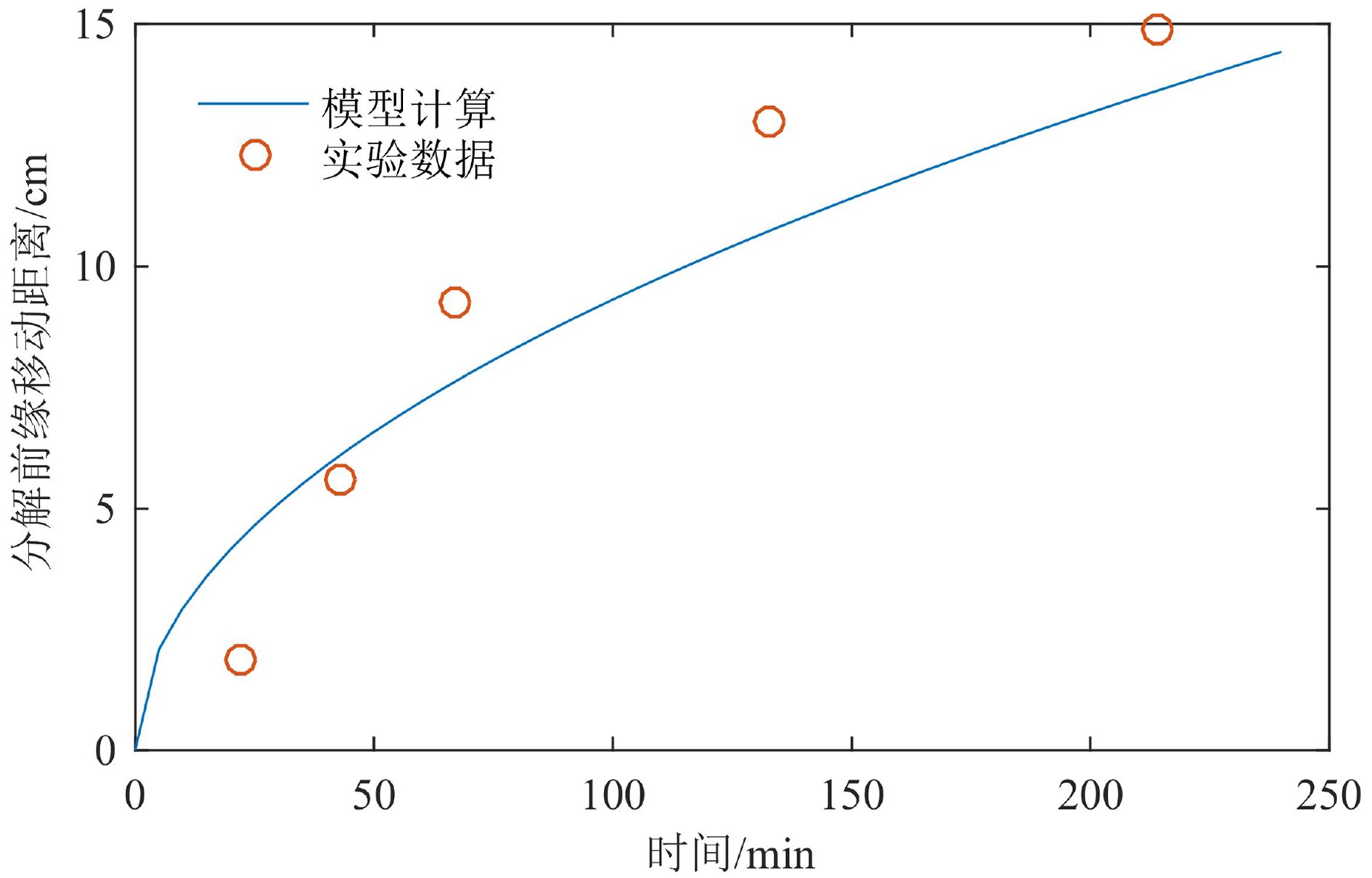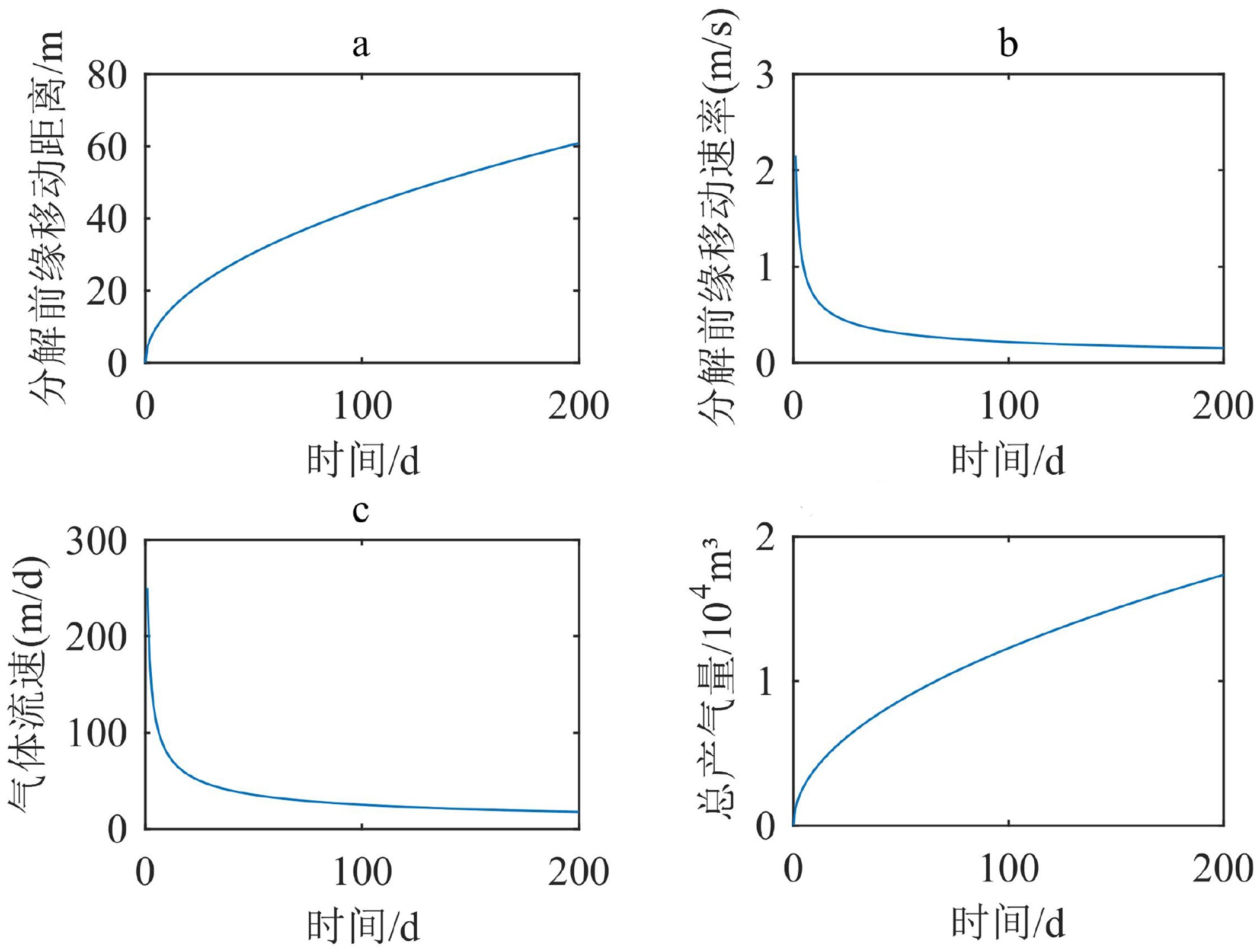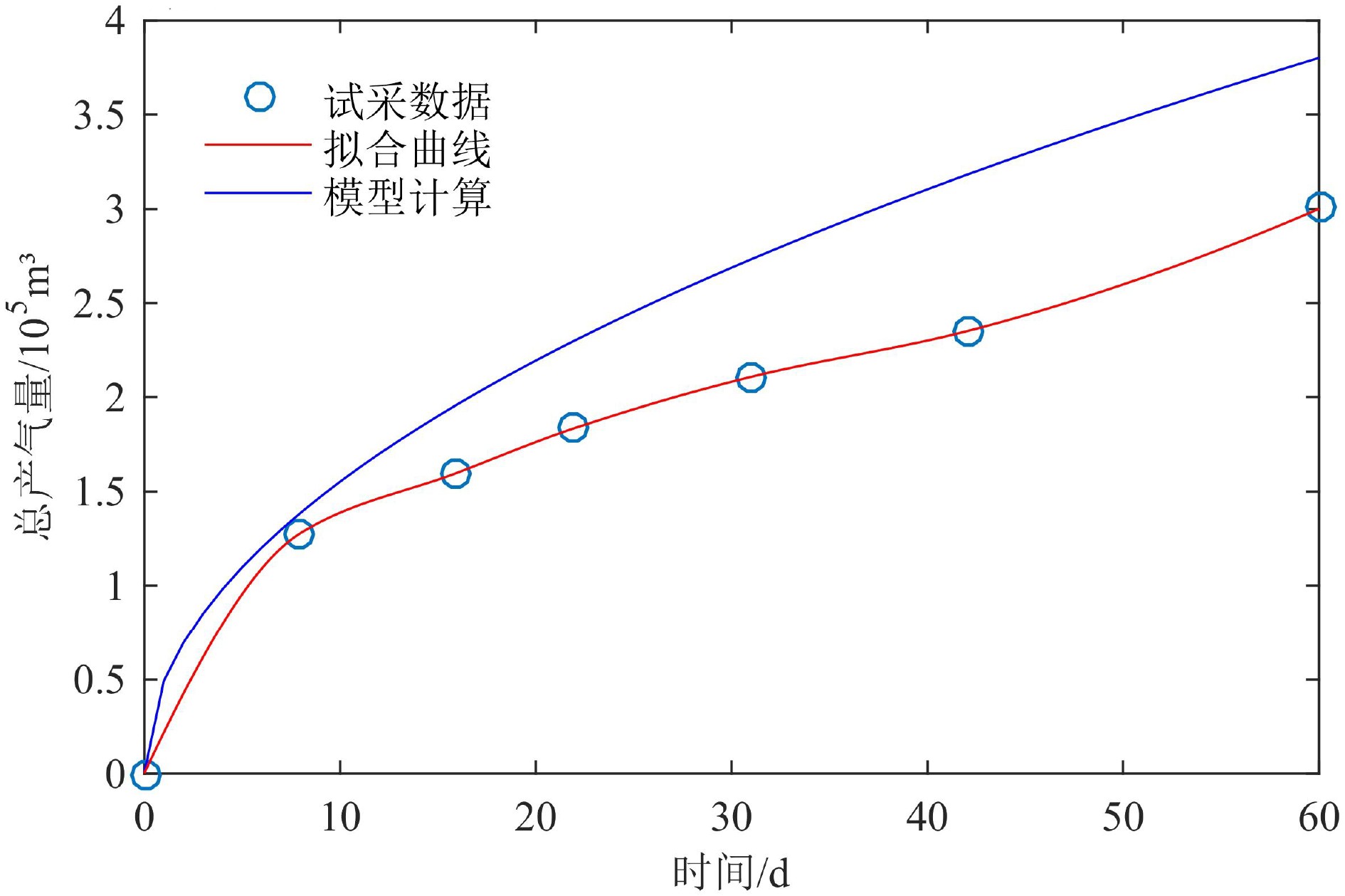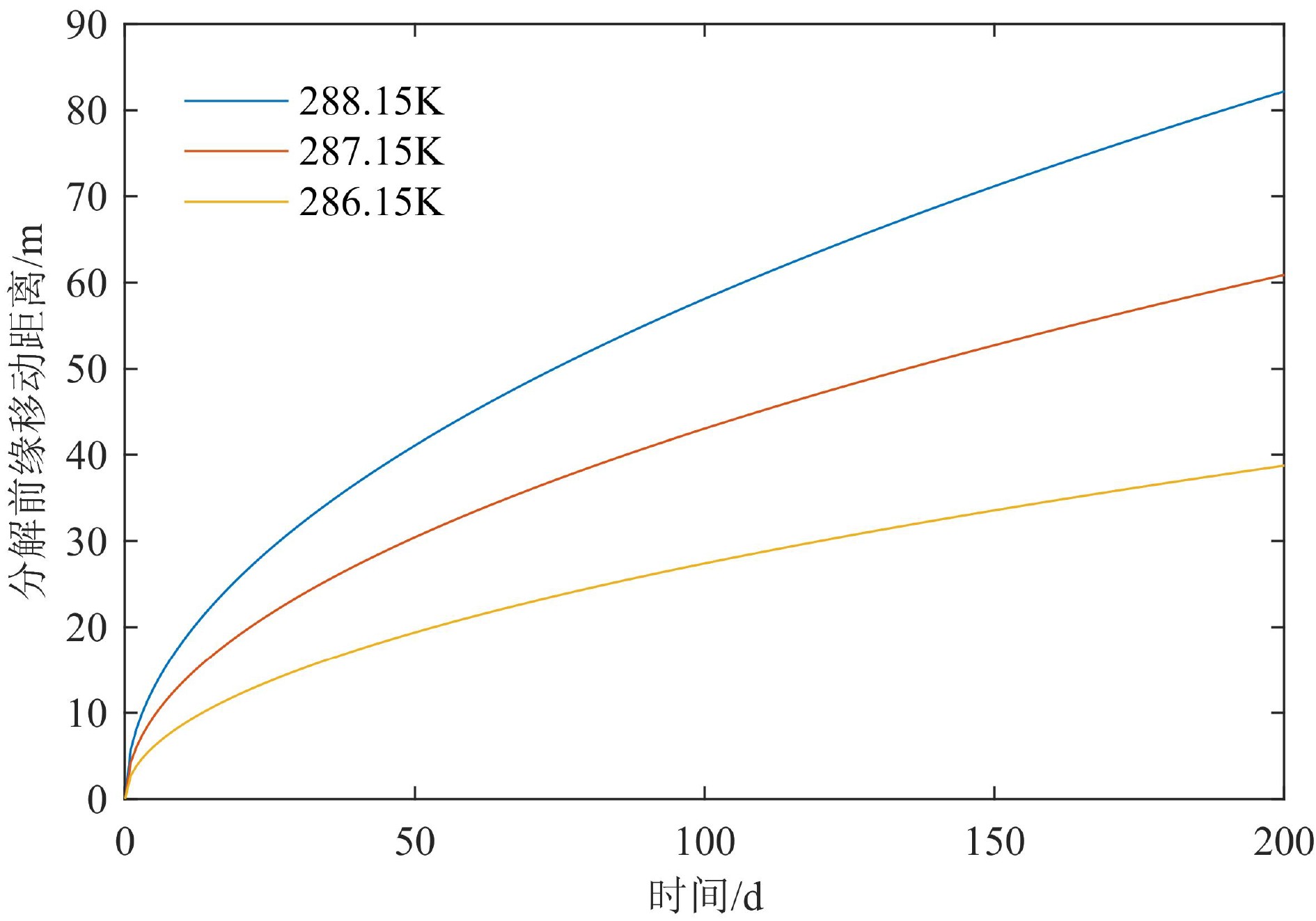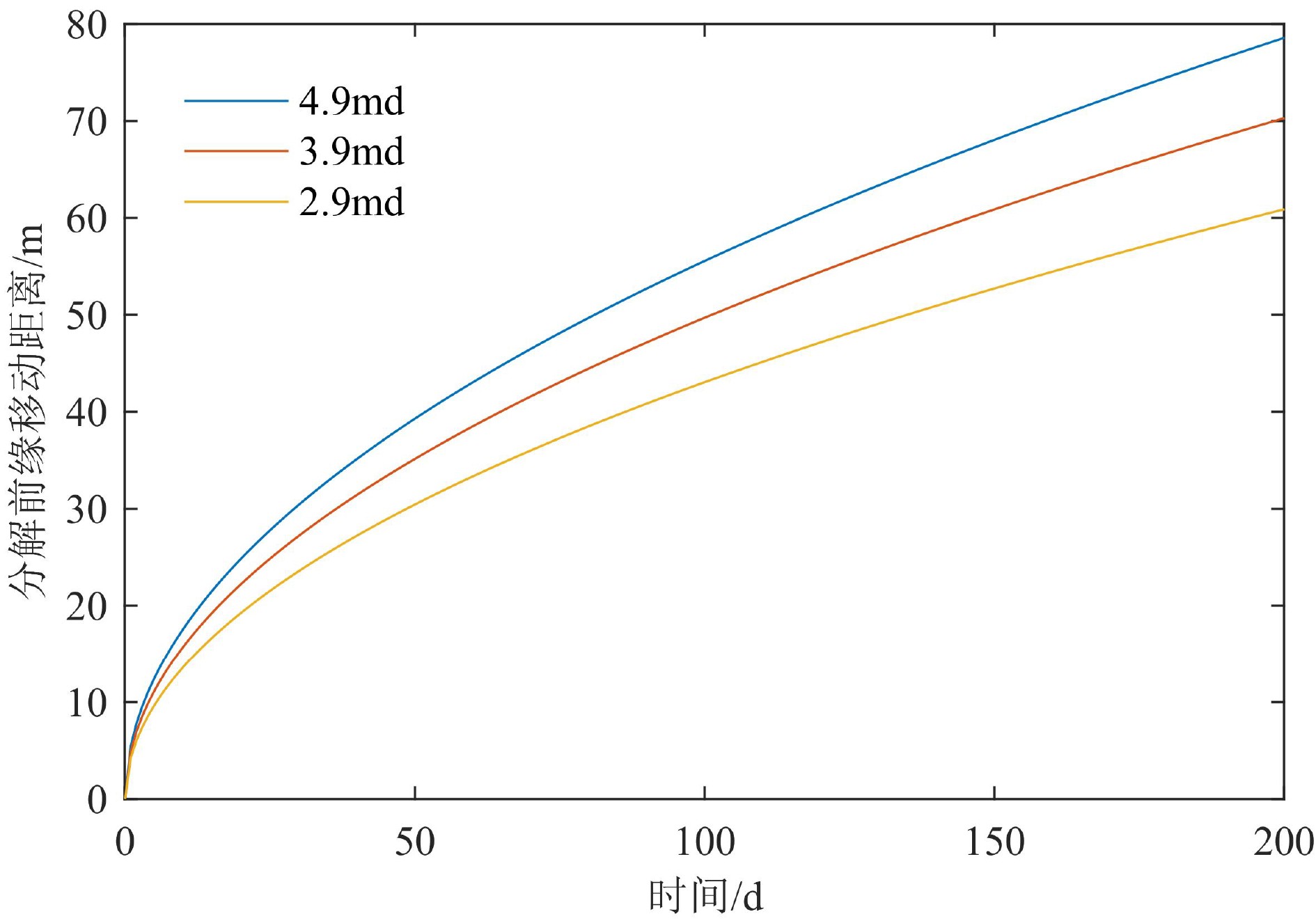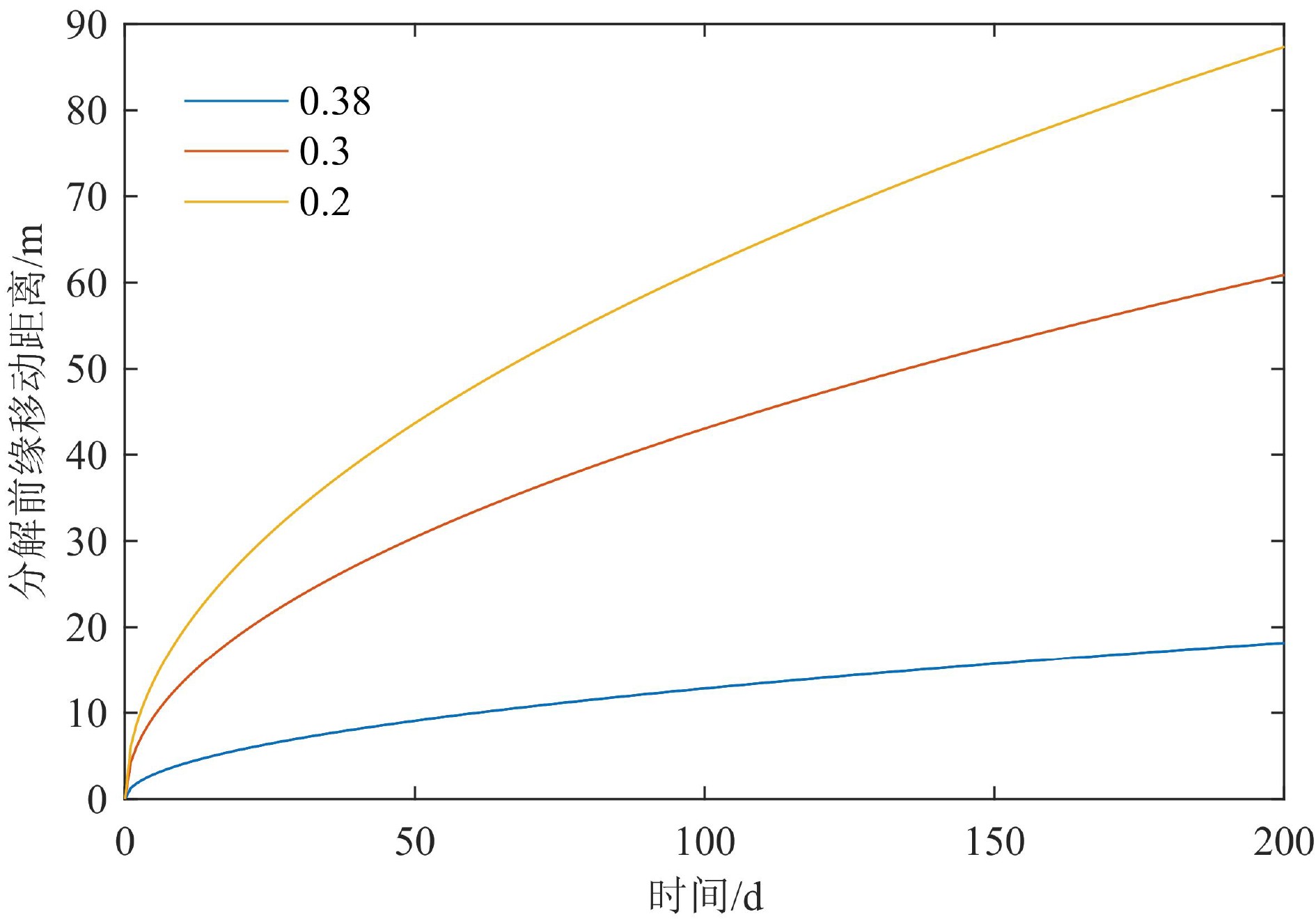Numerical study on the movement of the decomposition front of natural gas hydrate under depressurization
-
摘要:
在水合物分解过程中,已经分解的区域与未分解的区域之间存在一个过渡带,即分解前缘,研究分解前缘移动规律有助于认识水合物分解特征和进一步预测分解气量,对实际开采以及开采潜力评价提供大方向的科学参考。本文依据Stefan边界理论建立水合物分解前缘一维三相数学模型,通过参数量级分析,将水合物分解渗流场作为拟定常场,解析计算得到分解前缘随时间移动函数,同时将温度场方程无维化转换后,得到计算温度变化的超越方程。据分解前缘移动函数进一步计算总产气量以及井口产气速率。结合模型算例,认为水合物分解前缘移动与时间的平方根呈线性关系,移动速率随时间推移而减小,产气速率在开采前期达到峰值后快速下降达到稳定值。另外,以南海神狐海域第一次试采结果为依据,对比发现模型计算总气量高于实际试采值,两者相对误差在可接受范围内。因此,本文对水合物开采特征评价提供了一种新的简单计算方法,并对开采潜力给出了乐观的预测。最后,通过对地层初始温度、绝对渗透率以及孔隙度敏感性分析发现,地层初始温度和渗透率增大,水合物分解前缘移动距离随之增大,初始地层温度对水合物分解影响显著。而地层孔隙度越大,分解前缘移动速率反而降低,移动距离减小,井口与分解前缘压差减小,此时分解前缘移动由储层热物理参数决定。
Abstract:In the process of hydrate decompression, there occurs a decomposition front between the decomposed and undecomposed regions of gas hydrate reservoir. Studying the movement of the decomposition front may help to understand the hydrate decomposition characteristics and further predict the gas volume, which will provide a scientific reference for the actual exploitation potential. In this paper, a one-dimensional and three-phase mathematical model is established. After analyzing the parameter magnitude, the movement of gas and water in hydrate reservoir is regarded as steady flow, and the decomposition front is calculated. Meanwhile, the temperature field equations were dimensionless trans-formed to obtain the transcendental equations for calculating temperature. Combined with the model example, it is considered that the movement of the hydrate decomposition front is linear with the square root of time, and the gas production rate rapidly decreases to a stable value after reaching the peak in the early period. In addition, based on the results of the first trial production in Shen Hu area of the South China Sea, it is found that the total gas production calculated by the model is higher than the actual trial production value, and the relative error is within the acceptable range. Therefore, this paper provides a new simple calculation method for hydrate exploitation characteristics, and gives an optimistic prediction for the exploitation potential. Finally, through sensitivity analyses of the initial temperature, absolute permeability and porosity, it is found that with the increase of the initial temperature and permeability of the formation, the moving distance of the hydrate decomposition front will increase, and the initial formation temperature has a significant effect on the decomposition of hydrate. As the porosity of the formation gets greater, the movement rate of the decomposition front decreases, the moving distance decreases, and the pressure difference between the wellhead and the decomposition front decreases. At this time, the movement of the decomposition front is determined by the thermal physical parameters of the reservoir.
-
Key words:
- gas hydrate /
- decomposition front /
- depressurization /
- theoretical model
-

-
表 1 初始条件与边界条件
Table 1. Initial conditions and boundary conditions
初边值条件 值 初始地层压力( 

初始地层温度( 

井底压力(  )
)
外边界压力(  )
)
外边界温度(  )
)
表 2 相关物性参数
Table 2. The correlated parameters used for calculation
参数 数值 水合物密度  (kg/m3)
(kg/m3)910 岩石密度  (kg/m3)
(kg/m3)2 650 水合物层厚度h(m) 40 水合物饱和度 
0.3 水合物层水饱和度 
0.7 孔隙度 
0.3 初始地层压力  (MPa)
(MPa)14.0 初始地层温度  (K)
(K)287.15 井底压力  (MPa)
(MPa)3.0 单位质量水合物中气体体积分数 
0.129 气体运动黏滞系数  (Pas)
(Pas)1.e-5 水相运动黏滞系数  (Pas)
(Pas)1.e-3 水合物层绝对渗透率K(md) 2.9 井筒地层绝对渗透率K(md) 150 水合物分解吸收热  (kJ/kg)
(kJ/kg)430 水合物导热系数  (W/mK)
(W/mK)2.11 岩石导热系数  (W/mK)
(W/mK)2.0 水导热系数  (W/mK)
(W/mK)0.58 水合物比热容  (KJ/kg K)
(KJ/kg K)2.22 水比热容  (KJ/kg K)
(KJ/kg K)4.2 岩石比热容  (KJ/kg K)
(KJ/kg K)1.0 -
[1] Konno Y, Fujii T, Sato A, et al. Key findings of the world's first offshore methane hydrate production test off the coast of japan: toward future commercial production [J]. Energy & Fuels, 2017, 31(3): 2607-2616.
[2] Aghajari H, Moghaddam M H, Zallaghi M. Study of effective parameters for enhancement of methane gas production from natural gas hydrate reservoirs [J]. Green Energy & Environment, 2019, 4(4): 453-469.
[3] Moridis G J, Reagan M T, Queiruga A F, et al. Evaluation of the performance of the oceanic hydrate accumulation at site NGHP-02-09 in the Krishna-Godavari Basin during a production test and during single and multi-well production scenarios [J]. Marine and Petroleum Geology, 2019, 108: 660-696. doi: 10.1016/j.marpetgeo.2018.12.001
[4] Huang L, Su Z, Wu N Y, et al. Analysis on geologic conditions affecting the performance of gas production from hydrate deposits [J]. Marine and Petroleum Geology, 2016, 77: 19-29. doi: 10.1016/j.marpetgeo.2016.05.034
[5] Li S, Zheng R, Xu X, et al. Dissociation of methane hydrate by hot brine [J]. Petroleum Science and Technology, 2015, 33(6): 671-677. doi: 10.1080/10916466.2015.1005845
[6] Li F G, Yuan Q, Li T D, et al. A review: enhanced recovery of natural gas hydrate reservoirs [J]. Chinese Journal of Chemical Engineering, 2019, 27(9): 2062-2073. doi: 10.1016/j.cjche.2018.11.007
[7] Kurihara M, Sato A, Ouchi H, et al. Prediction of gas productivity from eastern nankai trough methane-hydrate reservoirs [J]. SPE Reservoir Evaluation & Engineering, 2009, 12(3): 477-499.
[8] 李淑霞, 武迪迪, 王志强, 等. 神狐水合物藏降压开采分解前缘数值模拟研究[J]. 中国科学: 物理学 力学 天文学, 2019, 49(3):112-122
LI Shuxia, WU Didi, WANG Zhiqiang, et al. Numerical simulation of dissociation front of shenhu hydrate reservoirs by depressurization [J]. SCIENTIA SINICA Physica, Mechanica & Astronomica, 2019, 49(3): 112-122.
[9] Fujii T, Suzuki K, Takayama T, et al. Geological setting and characterization of a methane hydrate reservoir distributed at the first offshore production test site on the Daini-Atsumi Knoll in the eastern Nankai Trough, Japan [J]. Marine and Petroleum Geology, 2015, 66: 310-322. doi: 10.1016/j.marpetgeo.2015.02.037
[10] Makogon Y F. Hydrates of Hydrocarbons[M]. Oklahoma: Pennwell Books, 1997.
[11] Verigin N N, Khabibullin I L, Khalikov G A. Linear problem of the dissociation of the hydrates of a gas in a porous medium [J]. Fluid Dynamics, 1980, 15(1): 144-147. doi: 10.1007/BF01089829
[12] Ji C, Ahmadi G, Smith D H. Natural gas production from hydrate decomposition by depressurization [J]. Chemical Engineering Science, 2001, 56(20): 5801-5814. doi: 10.1016/S0009-2509(01)00265-2
[13] 喻西崇, 吴应湘, 安维杰, 等. 开采地层中的天然气水合物的数学模型[J]. 天然气工业, 2004, 24(1):63-67
YU Xichong, WU Yingxiang, AN Weijie, et al. Mathematical model to recover gas hydrate from formations [J]. Natural Gas Industry, 2004, 24(1): 63-67.
[14] 唐良广, 李刚, 冯自平, 等. 热力法开采天然气水合物的数学模拟[J]. 天然气工业, 2006, 26(10):105-107
TANG Guangliang, LI Gang, FENG Ziping, et al. Mathematic modeling on thermal recovery of natural gas hydrate [J]. Natural Gas Industry, 2006, 26(10): 105-107.
[15] 张旭辉, 刘艳华, 李清平, 等. 沉积物中导热体周围水合物分解范围研究[J]. 力学与实践, 2010, 32(2):39-41, 25
ZHANG Xuhui, LIU Yanhua, LI Qingping, et al. The dissociation scope of gas hydrate in deposit around heat conductor [J]. Mechanics in Engineering, 2010, 32(2): 39-41, 25.
[16] 刘乐乐, 鲁晓兵, 张旭辉. 天然气水合物分解区演化数值分析[J]. 石油学报, 2014, 35(5):941-951
LIU Lele, LU Xiaobin, ZHANG Xuhui, et al. Numerical analysis on evolution of natural gas hydrate decomposition region in hydrate-bearing sedim [J]. Acta Petrolei Sinica, 2014, 35(5): 941-951.
[17] Li M C, Fan S S, Su Y L, et al. Mathematical models of the heat-water dissociation of natural gas hydrates considering a moving Stefan boundary [J]. Energy, 2015, 90: 202-207. doi: 10.1016/j.energy.2015.05.064
[18] Long X Y, Tjok K, Adhikari S. Numerical investigation on gas hydrate production by depressurization in hydrate-bearing reservoir[C]//Proceedings of the ASME 35th International Conference on Ocean, Offshore and Arctic Engineering. Busan: ASME, 2016.
[19] Zheng R Y, Li S X, Li X L. Sensitivity analysis of hydrate dissociation front conditioned to depressurization and wellbore heating [J]. Marine and Petroleum Geology, 2018, 91: 631-638. doi: 10.1016/j.marpetgeo.2018.01.010
[20] Ji C, Ahmadi G, Smith D H. Constant rate natural gas production from a well in a hydrate reservoir [J]. Energy Conversion and Management, 2003, 44(15): 2403-2423. doi: 10.1016/S0196-8904(03)00010-4
[21] Tsypkin G G. Mathematical model for dissociation of gas hydrates coexisting with gas in strata [J]. Doklady Physics, 2001, 46(11): 806-809. doi: 10.1134/1.1424377
[22] Wang G X, Prasad V, Matthys E F. An interface-tracking numerical method for rapid planar solidification of binary alloys with application to microsegregation [J]. Materials Science and Engineering: A, 1997, 225(1-2): 47-58. doi: 10.1016/S0921-5093(96)10577-3
[23] Tsypkin G G. Formation of the impermeable layer in the process of methane hydrate dissociation in porous media [J]. Fluid Dynamics, 2017, 52(5): 657-665. doi: 10.1134/S0015462817050076
[24] Tsypkin G G. Analytical solution of the nonlinear problem of gas hydrate dissociation in a formation [J]. Fluid Dynamics, 2007, 42(5): 798-806. doi: 10.1134/S0015462807050122
[25] Ahmadi G, Ji C, Smith D H. Natural gas production from hydrate dissociation: an axisymmetric model [J]. Journal of Petroleum Science and Engineering, 2007, 58(1-2): 245-258. doi: 10.1016/j.petrol.2007.01.001
[26] Makogon T Y, Larsen R, Knight C A, et al. Melt growth of tetrahydrofuran clathrate hydrate and its inhibition: method and first results [J]. Journal of Crystal Growth, 1997, 179(1-2): 258-262. doi: 10.1016/S0022-0248(97)00118-8
[27] Ostrach S. Role of analysis in the solution of complex physical problems[C]//International Heat Transfer Conference 3. 2019.
[28] Yousif M H, Li P M, Selim M S, et al. Depressurization of natural gas hydrates in berea sandstone cores [J]. Journal of Inclusion Phenomena and Molecular Recognition in Chemistry, 1990, 8(1-2): 71-88. doi: 10.1007/BF01131289
[29] Su Z, Cao Y C, Wu N Y, et al. Numerical analysis on gas production efficiency from hydrate deposits by thermal stimulation: application to the Shenhu Area, South China Sea [J]. Energies, 2011, 4(2): 294-313. doi: 10.3390/en4020294
[30] Feng J C, Wang Y, Li X S, et al. Production performance of gas hydrate accumulation at the GMGS2-Site 16 of the Pearl River Mouth Basin in the South China Sea [J]. Journal of Natural Gas Science and Engineering, 2015, 27: 306-320. doi: 10.1016/j.jngse.2015.08.071
[31] Sun Y H, Ma X L, Guo W, et al. Numerical simulation of the short- and long-term production behavior of the first offshore gas hydrate production test in the South China Sea [J]. Journal of Petroleum Science and Engineering, 2019, 181: 106196. doi: 10.1016/j.petrol.2019.106196
[32] Chen L, Feng Y C, Okajima J, et al. Production behavior and numerical analysis for 2017 methane hydrate extraction test of Shenhu, South China Sea [J]. Journal of Natural Gas Science and Engineering, 2018, 53: 55-66. doi: 10.1016/j.jngse.2018.02.029
[33] Giraldo C, Klump J, Clarke M, et al. Sensitivity analysis of parameters governing the recovery of methane from natural gas hydrate reservoirs [J]. Energies, 2014, 7(4): 2148-2176. doi: 10.3390/en7042148
[34] Wang D Y, Ma X J, Qiao J. Impact factors of natural gas hydrate dissociation by depressurization: a review [J]. Advanced Materials Research, 2014, 868: 564-567.
[35] Konno Y, Oyama H, Nagao J, et al. Numerical analysis of the dissociation experiment of naturally occurring gas hydrate in sediment cores obtained at the eastern Nankai trough, Japan [J]. Energy & Fuels, 2010, 24(12): 6353-6358.
[36] Sun X, Luo T T, Wang L, et al. Numerical simulation of gas recovery from a low-permeability hydrate reservoir by depressurization [J]. Applied Energy, 2019, 250: 7-18. doi: 10.1016/j.apenergy.2019.05.035
[37] Kaviany M. Principles of heat transfer in porous media [J]. Mechanical Engineering, 1991, 49(5): B103-B104.
-



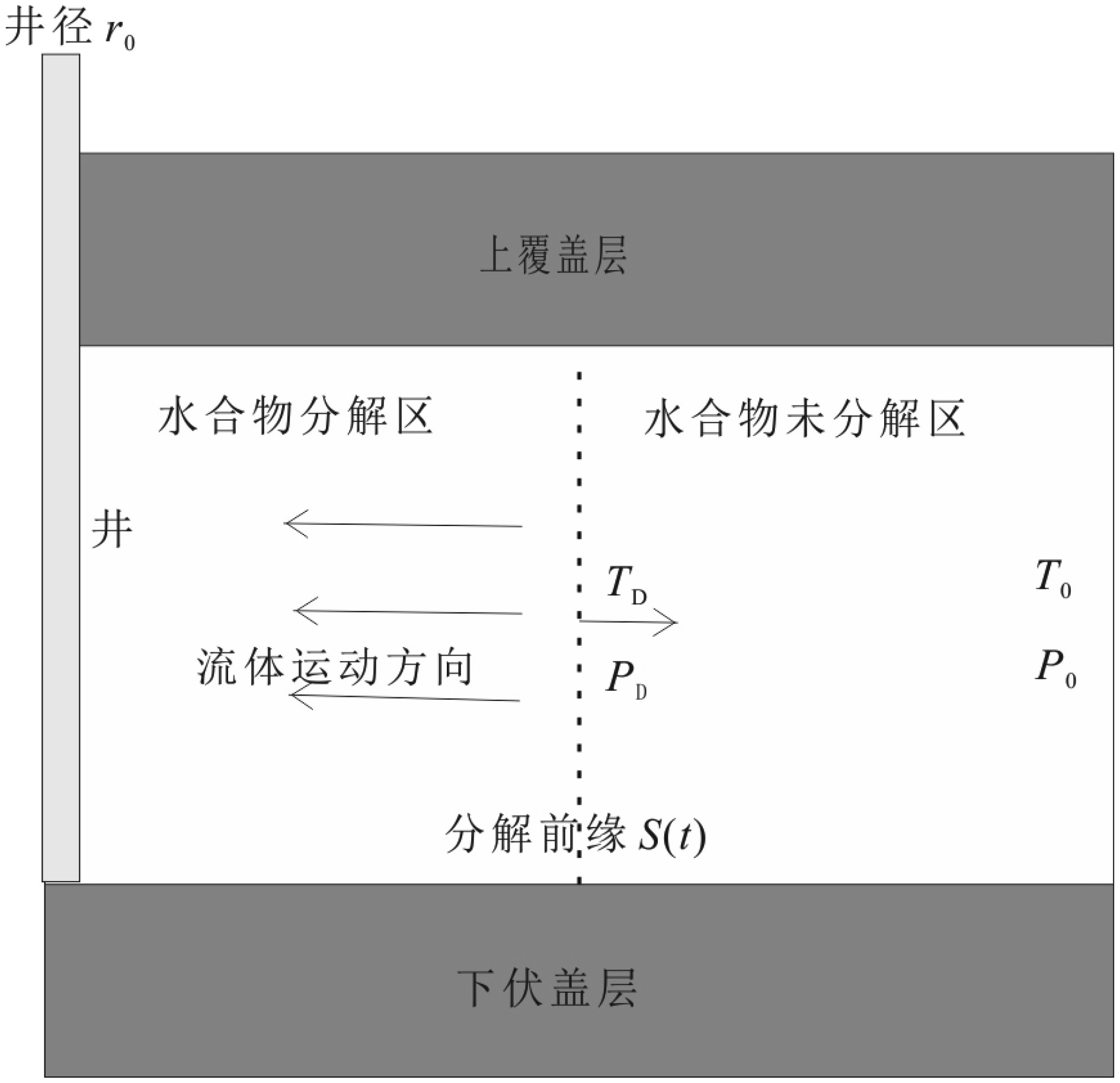
 下载:
下载:
